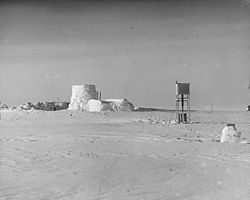Ice center
| Ice center | ||
|---|---|---|
|
|
||
| Coordinates | 71 ° 11 ′ N , 39 ° 56 ′ W | |
| Basic data | ||
| Country | Greenland | |
| ISO 3166-2 | GL | |
|
Photo of the station Eismitte 1930
|
||
Ice center was a wintering station of Alfred Wegener's Greenland expedition (July 1930 to August 1931) in the Greenland Ice Sheet . The coordinates of the station, which was buried in the snow and ice, were 71 ° 11 'north and 39 ° 56' west, at an altitude of 3,010 meters. The distance to the nearest coast was 402 km.
From September 1, 1930 to August 31, 1931, temperature extremes between −64.9 ° C and −2.8 ° C were measured at the station. The coldest month (February 1931) had an average temperature of −47.2 ° C, the warmest (July 1931) −12.2 ° C. During the same period, a rainfall of 110 mm was measured (most of it surprisingly in winter). The width of the station is midnight sun from May 13th to July 30th , while it is polar night from November 23rd to January 20th .
The location of the station falls today in the area of the Northeast Greenland National Park , slightly north of the northern border of the former municipality of Ittoqqortoormiit .
history
The meteorologist Johannes Georgi was appointed head of the Eismitte station by Wegener. Georgi made the first sleigh trip to Eismitte to set up the station and begin meteorological measurements. Due to time problems and difficult weather conditions, it was only possible to provide the station with sufficient supplies with three transports. In addition, driven by a message from Georgi and Ernst Sorge that they would give up the station without additional food and fuel, Wegener made a fourth and final transport trip with meteorologist Fritz Loewe and 13 Greenlanders before wintering. This trip started on September 21st. Because of the early onset of snow storms this year, the transport had to be abandoned. The Greenlanders returned home except for Rasmus Villumsen (1909–1930). The goal of those traveling on was only to replace Georgi and Sorge for the winter. Wegener, Loewe and Villumsen reached mid-ice on October 30th, using up all their reserves. Loewe's toes were frozen to death on the last few days of the trip. These were amputated by Georgi. Wegener and Villumsen started their return journey on November 1st, which they did not survive.
Observations were made under extremely harsh conditions throughout the winter. Georgi was responsible for meteorological measurements and was responsible for the glaciological investigation of the ice itself. To this end, he dug a 16 meter deep shaft and carried out the first density and temperature profile measurements in the Greenland Ice Sheet . The importance of this pioneering achievement in glaciology was only recognized decades later, when profile measurements became important for research into climate change . During the six-month hibernation in the station's firn cave, Loewe had to stay in the sleeping bag and was unable to support the two of them with their scientific work.
On May 7th, a propeller sledge reached Eismitte for the first time , which brought the Loewe, who was still in poor health, to the west station in just two days. On the same day a team of dogs also arrived. Georgi made sure that the measurements were continued in order to obtain a complete observation year and occupied the station alone for up to 10 weeks. He kept his experiences in the middle of the ice in the book Buried in the Ice. Experiences at station Eismitte of Alfred Wegener's last Greenland expedition .
See also
literature
- Johannes Georgi: Buried in the ice. Experiences at the ice center station of Alfred Wegener's last Greenland expedition . Publishing house of the Blodig Alpine Calendar Müller, Munich 1933
- Else Wegener and Fritz Loewe: Alfred Wegener's last trip to Greenland. The experiences of the German Greenland expedition in 1930/1931 described by his traveling companions and according to the researcher's diaries . Brockhaus, Leipzig 1932
- Ursula Rack: Socio-historical study on polar research based on German and Austro-Hungarian polar expeditions between 1868–1939 (PDF; 28.6 MB). Reports on polar and marine research 618, Alfred Wegener Institute for Polar and Marine Research, Bremerhaven 2010
- Klaus Rohrbach: Adventure in snow and ice - Alfred Wegener polar explorer and discoverer of the wandering continents . Free Spiritual Life Publishing House 2008. ISBN 978-3-7725-1758-7
- Anna-Lena Meyer: Caught in the middle of the ice , in: Eva Schöck-Quinteros / Anna Stock-Mamzer / Christian Salewski (eds.): Bitten by the ice - buried in the ice. Stories from German polar research ( from the files on stage 13), Bremen 2018, pp. 153 - 185. ISBN 978-3-88722-758-6
Individual evidence
- ^ Fritz Loewe: The Greenland Ice Sheet according to new findings . In: Erdkunde 18, 1964, pp. 189-202
- ^ Fritz Loewe: Johannes Georgi (PDF; 393 kB). In: Polarforschung 42, 1972, pp. 155-158
- ^ The German Greenland Expedition 1930/31 ( Memento from March 15, 2015 in the Internet Archive ), Alfred Wegener Institute for Polar and Marine Research.
- ^ Herrmann A. Hahne: Dr. Ernst Sorge (PDF; 201 kB). In: Polarforschung , 16, 1946, pp. 120-121
- ^ John D. Cox: Climate Crash: Abrupt Climate Change and what it Means for Our Future . National Academies Press. 2005. ISBN 0-309-09312-0 , p. 15
- ^ Karl Weiken : Fritz Loewe (PDF; 427 kB). In: Polarforschung 44, 1974, pp. 93-95
Web links
- Hourly meteorological parameters measured by Johannes Georgi and colleagues at the Eismitte station ( doi : 10.1594 / PANGEA.604003 ).




